SolusVM Extended Cloud For WHMCS
(→Installation and Configuration) |
(→Management) |
||
| Line 309: | Line 309: | ||
=Management= | =Management= | ||
{| | {| | ||
| − | |style="padding: 10px 0px 30px 15px;"|'''SolusVM Extended Cloud For WHMCS is very simple and convenient in use. Your customers are only a few clicks away from creating their own servers.'''<br /> | + | |style="padding: 10px 0px 30px 15px;"|'''SolusVM Extended Cloud For WHMCS is very simple and convenient in use. Your customers are only a few clicks away from creating their own servers.'''<br/> |
| − | The module will allow your customers to manage multiple servers and freely change their resources. Everything within your own WHMCS client area.<br /> | + | The module will allow your customers to manage multiple servers and freely change their resources. Everything within your own WHMCS client area.<br/> |
| − | Owing to integration with Advanced Billing For WHMCS you can even offer product, which your client will be billed for depending on its usage. | + | Owing to integration with Advanced Billing For WHMCS you can even offer product, which your client will be billed for depending on its usage. |
| − | + | ||
|} | |} | ||
==Interface== | ==Interface== | ||
{| | {| | ||
| − | |style="padding: 10px 0px 15px 15px;"|Now, let's check the interface of the module in the client area where you customers can create and manage virtual servers.<br /> | + | |style="padding: 10px 0px 15px 15px;"|Now, let's check the interface of the module in the client area where you customers can create and manage virtual servers.<br/> |
''Note: Screen below presents the module right after creation of the product. More features will be displayed after creating a server.'' | ''Note: Screen below presents the module right after creation of the product. More features will be displayed after creating a server.'' | ||
|} | |} | ||
| Line 323: | Line 323: | ||
|} | |} | ||
{| | {| | ||
| − | |style="padding: 0px 0px 15px 15px;"|You can manage each product from your WHMCS admin area.<br /> | + | |style="padding: 0px 0px 15px 15px;"|You can manage each product from your WHMCS admin area.<br/> |
In addition to that, each VPS created by your clients can be easily monitored. | In addition to that, each VPS created by your clients can be easily monitored. | ||
|} | |} | ||
| Line 343: | Line 343: | ||
|} | |} | ||
{| | {| | ||
| − | |style="padding: 0px 0px 15px 15px;"|As you can see on the screen below, virtual server has been successfully created.<br /> | + | |style="padding: 0px 0px 15px 15px;"|As you can see on the screen below, virtual server has been successfully created.<br/> |
Now let's see how we can manage our new server. To proceed, click on '' 'Manage' '' button. | Now let's see how we can manage our new server. To proceed, click on '' 'Manage' '' button. | ||
|} | |} | ||
| Line 350: | Line 350: | ||
|} | |} | ||
{| | {| | ||
| − | |style="padding: 0px 0px 15px 15px;"|One of the most interesting and useful options offered to the users is the upgrade.<br /> | + | |style="padding: 0px 0px 15px 15px;"|One of the most interesting and useful options offered to the users is the upgrade.<br/> |
Upgrade allows your customers to request a change of virtual server resources. | Upgrade allows your customers to request a change of virtual server resources. | ||
|} | |} | ||
| Line 371: | Line 371: | ||
{| | {| | ||
|style="padding: 0px 0px 20px 15px;"|Right next to '' 'Upgrade' '' option, there are '' 'Graphs'. ''<br/> | |style="padding: 0px 0px 20px 15px;"|Right next to '' 'Upgrade' '' option, there are '' 'Graphs'. ''<br/> | ||
| − | Press it to see generated statistics on '' 'Network Traffic', 'Load Average' '' and '' 'Memory Usage'. '' | + | Press it to see generated statistics on '' 'Network Traffic', 'Load Average' '' and '' 'Memory Usage'.'' |
|} | |} | ||
{| | {| | ||
| Line 382: | Line 382: | ||
==Dynamic Server Resources Setup With Configurable Options== | ==Dynamic Server Resources Setup With Configurable Options== | ||
{| | {| | ||
| − | |style="padding: 10px 0px 15px 15px;"|If you want to allow your clients to dynamically set servers with resources they choose, follow these steps.<br /> | + | |style="padding: 10px 0px 15px 15px;"|If you want to allow your clients to dynamically set servers with resources they choose, follow these steps.<br/> |
| − | Firstly, you should have a ready product. For more information on how to create one, head to '' '[http://www.docs.modulesgarden.com/SolusVM_Extended_VPS_For_WHMCS#Configuration_of_Product Configuration of Product]' '' instruction.<br /> | + | Firstly, you should have a ready product. For more information on how to create one, head to '' '[http://www.docs.modulesgarden.com/SolusVM_Extended_VPS_For_WHMCS#Configuration_of_Product Configuration of Product]' '' instruction.<br/> |
The final result visible on the order form should be similar to the one presented on the screen below. | The final result visible on the order form should be similar to the one presented on the screen below. | ||
|} | |} | ||
| Line 407: | Line 407: | ||
{| | {| | ||
|style="padding: 10px 0px 15px 15px;"|When you combine SolusVM Extended Cloud For WHMCS with [http://www.modulesgarden.com/products/whmcs/dns_manager/features DNS Manager For WHMCS], your clients will be able to manage PowerDNS zones and records from the client area.<br/> | |style="padding: 10px 0px 15px 15px;"|When you combine SolusVM Extended Cloud For WHMCS with [http://www.modulesgarden.com/products/whmcs/dns_manager/features DNS Manager For WHMCS], your clients will be able to manage PowerDNS zones and records from the client area.<br/> | ||
| − | DNS Manager For WHMCS will allow your customers to manage DNS zones, records and ReverseDNS.<br/>To connect both modules, go to '' 'Configuration' '' section of DNS Manager, move to '' 'Processing' '', select SolusVM Extended products and connect with PowerDNs server. | + | DNS Manager For WHMCS will allow your customers to manage DNS zones, records and ReverseDNS.<br/>To connect both modules, go to '' 'Configuration' '' section of DNS Manager, move to '' 'Processing' '', select SolusVM Extended products and connect with PowerDNs server.<br/> |
| + | '' '''Important:''' SolusVM Extended Cloud For WHMCS is compatible with DNS Manager For WHMCS V2.x.x.'' | ||
|} | |} | ||
{| | {| | ||
| Line 433: | Line 434: | ||
==Management of Billing== | ==Management of Billing== | ||
{| | {| | ||
| − | |style="padding: 10px 0px 15px 15px;"|When you combine SolusVM Extended Cloud For WHMCS with [http://www.docs.modulesgarden.com/Advanced_Billing_For_WHMCS Advanced Billing For WHMCS], you will be able to set up additional billing options.<br/> Enable '' 'Usage Records' '' extension for Solus Cloud products. | + | |style="padding: 10px 0px 15px 15px;"|When you combine SolusVM Extended Cloud For WHMCS with [http://www.docs.modulesgarden.com/Advanced_Billing_For_WHMCS Advanced Billing For WHMCS], you will be able to set up additional billing options.<br/>Enable '' 'Usage Records' '' extension for Solus Cloud products. |
|} | |} | ||
{| | {| | ||
| Line 453: | Line 454: | ||
==Update of Products== | ==Update of Products== | ||
{| | {| | ||
| − | |style="padding: 10px 0px 30px 15px;"|Our module is entirely compatible with SolusVM Pro module and you can easily upgrade your existing products without losing your settings.<br /> | + | |style="padding: 10px 0px 30px 15px;"|Our module is entirely compatible with SolusVM Pro module and you can easily upgrade your existing products without losing your settings.<br/> |
| − | 1. Go to '' 'Setup' '' → '' 'Products/Services' '' → '' 'Products/Services' '' → '' 'Module Settings' '' of your product and switch '' 'Module Name' '' from '' 'Solusvmpro' '' to '' 'SolusvmExtendedCloud' ''.<br /> | + | 1. Go to '' 'Setup' '' → '' 'Products/Services' '' → '' 'Products/Services' '' → '' 'Module Settings' '' of your product and switch '' 'Module Name' '' from '' 'Solusvmpro' '' to '' 'SolusvmExtendedCloud' ''.<br/> |
| − | 2. Proceed to '' 'Setup' '' → '' 'Products/Services' '' → '' 'Servers' '' and switch your server type from '' 'Solusvmpro' '' to '' 'SolusvmExtendedCloud' ''.<br /> | + | 2. Proceed to '' 'Setup' '' → '' 'Products/Services' '' → '' 'Servers' '' and switch your server type from '' 'Solusvmpro' '' to '' 'SolusvmExtendedCloud' ''.<br/> |
| − | 3. Now, click '' 'Setup' '' → '' 'Products/Services' '' → '' 'Products/Services' '' → '' 'Module Settings' '' of your product and make sure that '' 'Server Group' '' is set up correctly.<br /> | + | 3. Now, click '' 'Setup' '' → '' 'Products/Services' '' → '' 'Products/Services' '' → '' 'Module Settings' '' of your product and make sure that '' 'Server Group' '' is set up correctly.<br/> |
| − | 4. The last step is generating default configurable options and custom fields through clicking on '' 'Generate default' '' button.<br /> | + | 4. The last step is generating default configurable options and custom fields through clicking on '' 'Generate default' '' button.<br/> |
Your SolusVM Extended Cloud product is ready to use! | Your SolusVM Extended Cloud product is ready to use! | ||
|} | |} | ||
==Debug Mode== | ==Debug Mode== | ||
{| | {| | ||
| − | |style="padding: 10px 0px 15px 15px;"|SolusVM Extended Cloud is a very complex module. Therefore many things might go wrong.<br /> | + | |style="padding: 10px 0px 15px 15px;"|SolusVM Extended Cloud is a very complex module. Therefore many things might go wrong.<br/> |
| − | To help you quickly solve various problems usually connected with WHMCS product/server configuration and SolusVM server configuration, we created '' 'Debug Mode'. ''<br /> | + | To help you quickly solve various problems usually connected with WHMCS product/server configuration and SolusVM server configuration, we created '' 'Debug Mode'.''<br/> |
To enable it, go to '' 'Module Settings' '' of your product and tick '' 'Debug Mode' '' as shown on the screen below. | To enable it, go to '' 'Module Settings' '' of your product and tick '' 'Debug Mode' '' as shown on the screen below. | ||
|} | |} | ||
| Line 470: | Line 471: | ||
|} | |} | ||
{| | {| | ||
| − | |style="padding: 0px 0px 15px 15px;"|Afterwards, go to '' 'Utilities' '' → '' 'Logs' '' → '' 'Module Log' '' and click on '' 'Enable Debug Logging' '' in order to enable it. The button should change its value to '' 'Disable Debug Logging'. ''<br /> | + | |style="padding: 0px 0px 15px 15px;"|Afterwards, go to '' 'Utilities' '' → '' 'Logs' '' → '' 'Module Log' '' and click on '' 'Enable Debug Logging' '' in order to enable it. The button should change its value to '' 'Disable Debug Logging'. ''<br/> |
From that moment, each action performed by the module will be recorded in the log.<br /> | From that moment, each action performed by the module will be recorded in the log.<br /> | ||
| − | In that way, you can easily check whether module correctly fetches the information about virtual servers, nodes, templates, plans etc.<br /> | + | In that way, you can easily check whether module correctly fetches the information about virtual servers, nodes, templates, plans etc.<br/> |
| − | If it does not, that indicates a problem with WHMCS product/server configuration or problem with your SolusVM server.<br /> | + | If it does not, that indicates a problem with WHMCS product/server configuration or problem with your SolusVM server.<br/> |
The following screen presents an exemplary module log. | The following screen presents an exemplary module log. | ||
|} | |} | ||
Revision as of 08:54, 17 August 2016
Article update is ongoing on this page, watch out for broken links and unclear descriptions!
We are sorry for the inconvenience caused.
Contents |
About SolusVM Extended Cloud For WHMCS
| SolusVM Extended Cloud For WHMCS allows your customers to create and manage multiple virtual servers in your WHMCS client area. Clients will be able to freely resize and upgrade their servers within resource limit defined by you. |
- Admin Area Features:
| ✔ Create/Suspend/Unsuspend/Terminate User Account |
| ✔ View Server Status |
| ✔ View Graphs: Traffic, Load, Memory |
| ✔ Define Product Total Resource Limits: |
| ✔ Dynamically - Using Configurable Options |
| ✔ Statically - Using 'Module Settings' Fields |
| ✔ Define Resource Range To Create VPS Within It |
| ✔ Configure Client Area Features Per Product |
| ✔ Define OS Templates Available For Rebuild |
| ✔ Configure Friendly Names For OS Templates |
| ✔ Configure Friendly Names For Nodes |
| ✔ Toggle Root Password Storing In System Database |
| ✔ Run API Connection Test |
- Client Area Features:
| ✔ Create/Edit/Delete Server |
| ✔ Boot/Reboot/Shutdown/Rebuild Server |
| ✔ View Available Resources |
| ✔ Enable TUN/TAP And PAE |
| ✔ Change Password: Root, Client, SSH Console And VNC Console |
| ✔ Change Boot Order |
| ✔ View Server Status |
| ✔ View Graphs: Traffic, Load, Memory |
| ✔ Access SSH Console - OpenVZ And Xen Only |
| ✔ Access VNC Console - KVM And Xen HVM Only |
| ✔ Access NoVNC HTML5 Console - KVM And Xen HVM Only |
| ✔ Log In To Control Panel |
| ✔ View Friendly Names Of OS Templates |
| ✔ Send Email Templates After Creation Of Server Based On Its Type |
| ✔ Choose Server Resources While Ordering And Upgrade/Downgrade Them Freely |
- General Info:
| ✔ Supports OpenVZ, Xen and KVM Virtualization |
| ✔ Integrated With DNS Manager For WHMCS - Supports PowerDNS (read more) |
| ✔ Integrated With Advanced Billing For WHMCS - Server Resource Usage Billing (read more) |
| ✔ Multi-Language Support |
| ✔ Supports WHMCS Templates Five and Six |
| ✔ Supports WHMCS V5 and V6 |
- Available Configurable Options:
| ✔ Memory Limit |
| ✔ Storage Limit |
| ✔ Bandwidth Limit |
| ✔ CPU Cores Limit |
| ✔ IP Addresses Limit |
Installation and Configuration
| In this tutorial we will show you how to successfully install SolusVM Extended Cloud For WHMCS. We will guide you step by step through the whole installation and configuration process. |
| 1. Log in to your client area and download SolusVM Extended Cloud For WHMCS. |
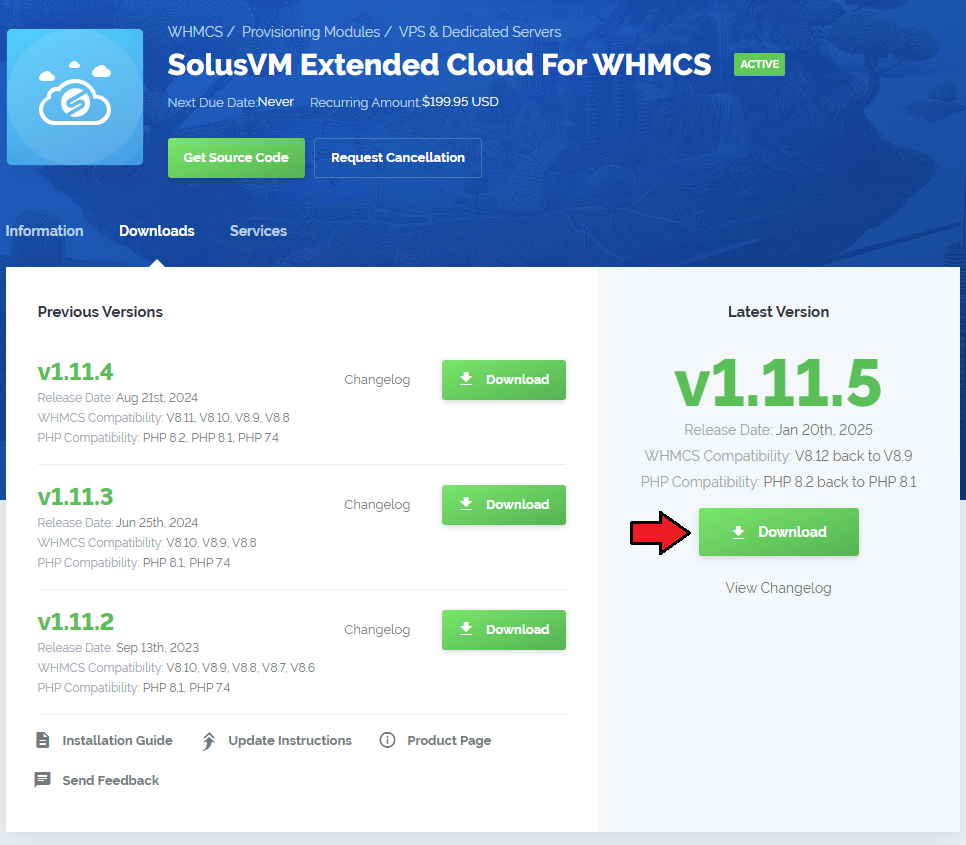
|
| 2. Upload and extract the module into the main WHMCS directory. Files in your WHMCS directory should look like these. |

|
| 3. When you install SolusVM Extended Cloud for the first time you have to rename 'license_RENAME.php' file. File is located in 'modules/servers/solusvmExtendedCloud/license_RENAME.php'. Rename it from 'license_RENAME.php' to 'license.php'. |
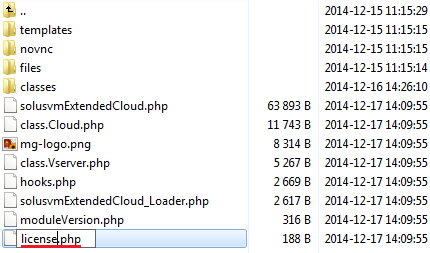
|
| 4. In order to configure your license key you have to edit a previously renamed 'license.php' file. Enter your license key between quotation marks as presented on the following screen. You can find your license key in your client area → 'My Products'. |

|
Configuration of API Access
| 5. Now, we will show you how to configure a new product. Firstly, log in to your SolusVM admin area, go to 'Configuration' → 'API Access' and press 'Add API User'. |

|
| 6. Enter your current IP and once again click on 'Add API User' button. |

|
Configuration of Server
| 7. Now, log in to your WHMCS admin area and go to 'Setup' → 'Products/Services' → 'Servers'. Afterwards, press 'Add New Server'. |
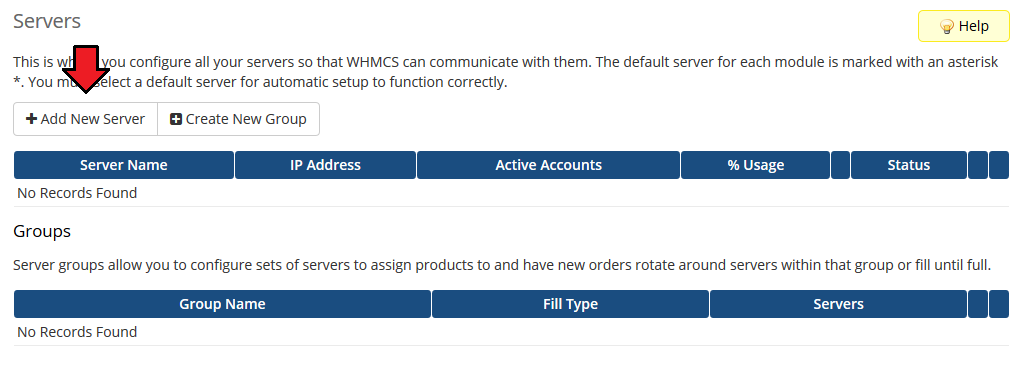
|
8. Enter your server name and IP address.
Choose 'SolusvmExtendedCloud' from a dropdown menu and press 'Save Changes'. |
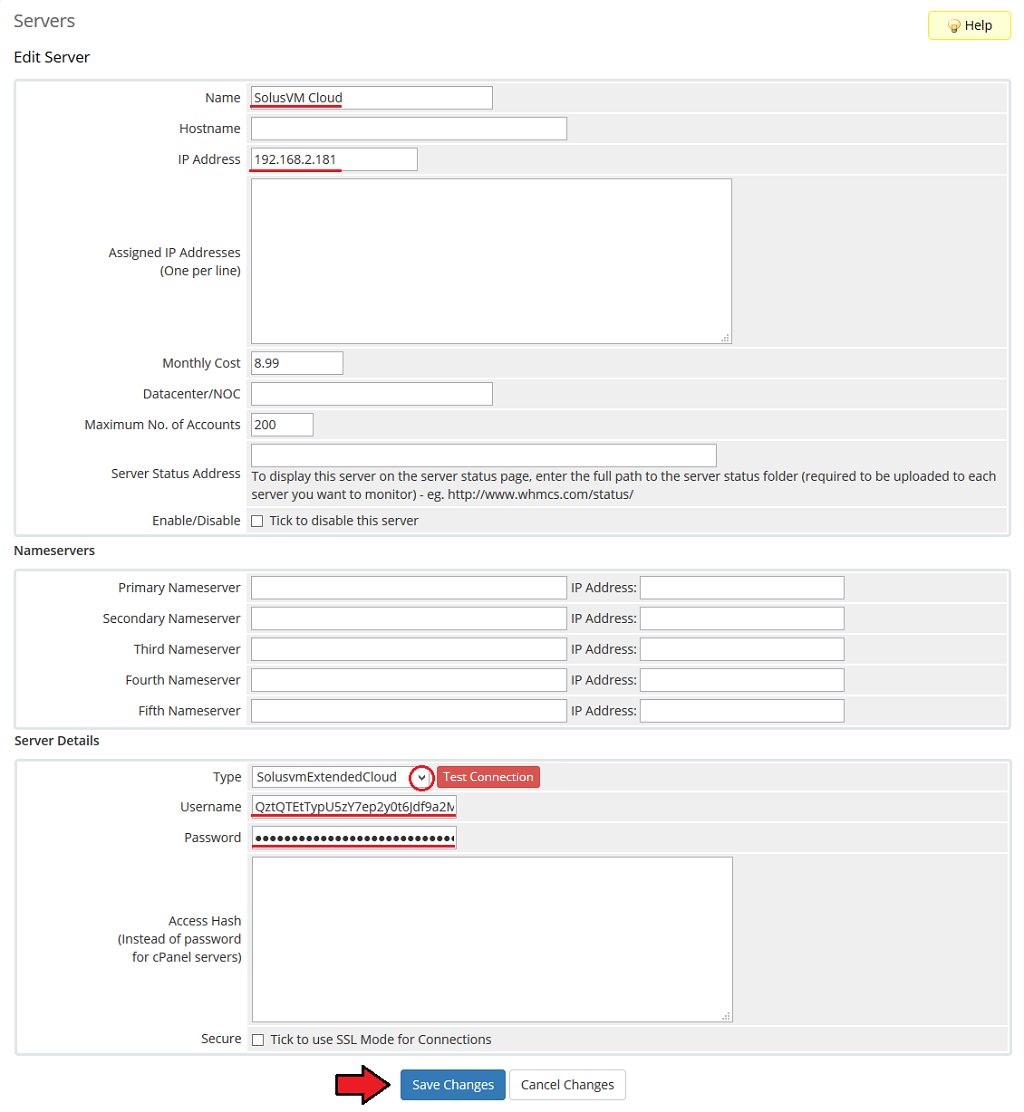
|
| 9. After you configure your server correctly, you will see a following screen. Test your connection through pressing 'Test Connection'. |
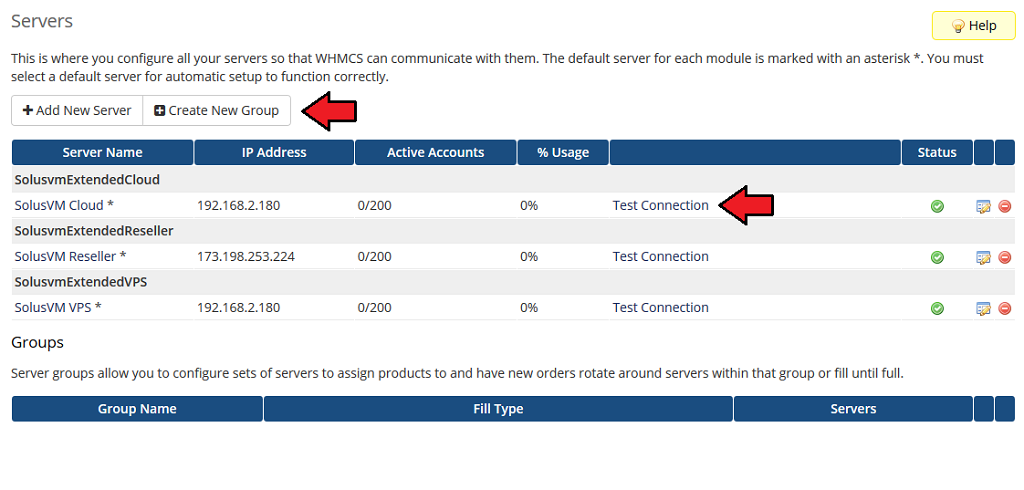
|
| 10. Enter name, click on a previously created server and press 'Add'. Afterwards, confirm through pressing 'Save Changes'. |
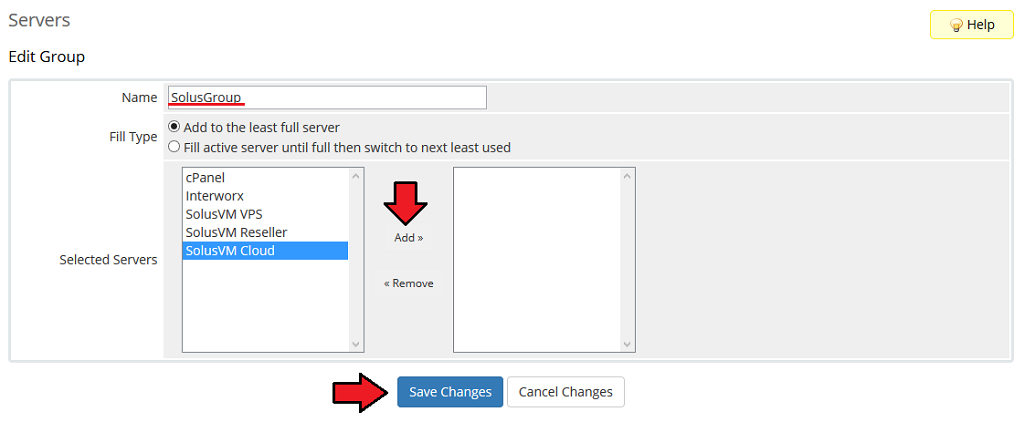
|
Configuration of Product
| 11. In order to create and configure a product, click on 'Setup' → 'Products/Services' → 'Products/Services'. Press 'Create a New Group'. |

|
| 12. Enter a product group name and press 'Save Changes'. |
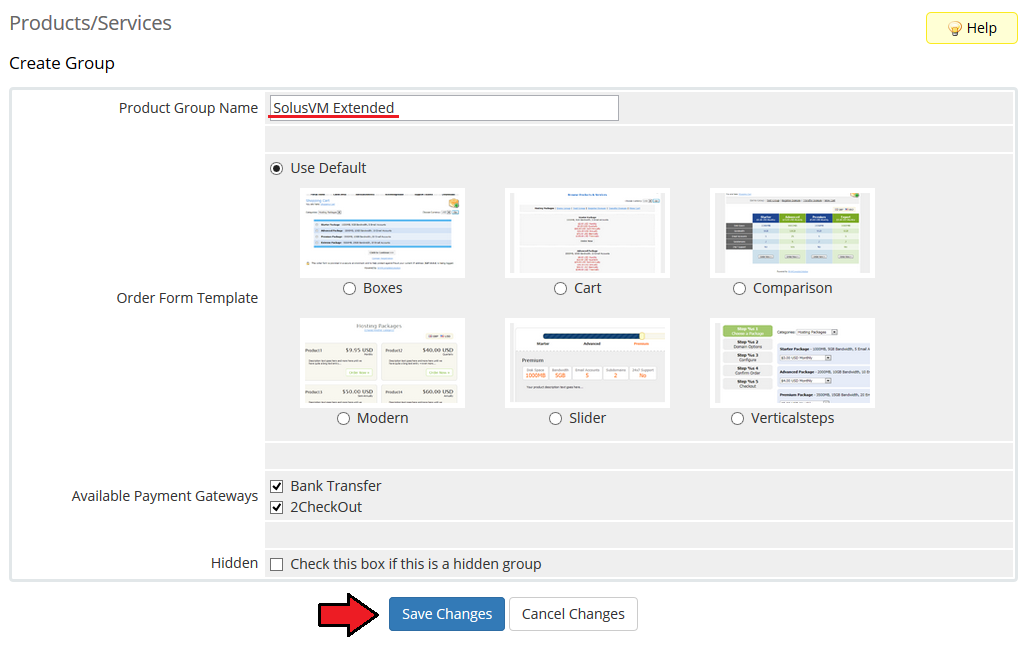
|
| 13. When you have a product group, you can create your product and assign it to SolusVM Extended Cloud. To create a product click on 'Create a New Product'. |

|
| 14. Afterwards, choose a product type and product group from dropdown menus, enter your product name and press 'Continue'. |

|
| 15. Now, go to 'Module Settings' section, choose both 'SolusvmExtendedCloud' and a previously created server group from dropdown menus. Afterwards, press 'Save Changes'. |
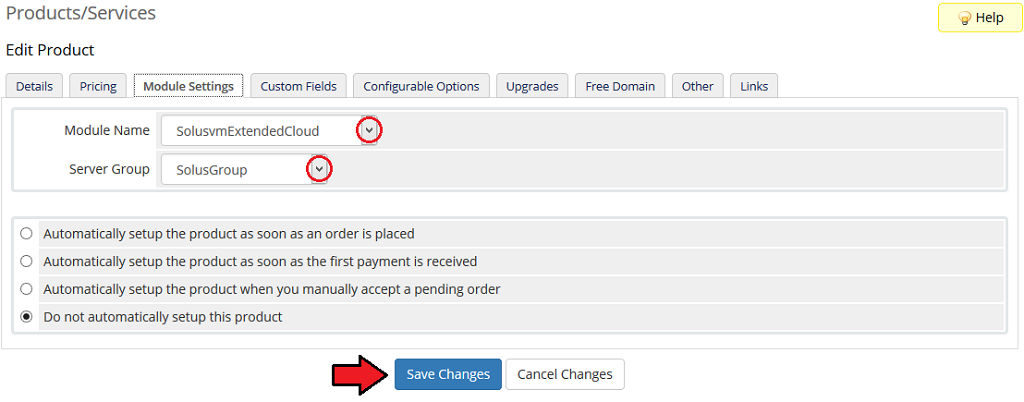
|
| 16. Select desired virtualization and press 'Save Changes'. All options of the selected virtualization will be loaded. Note that options availability differs according to a chosen virtualization! |
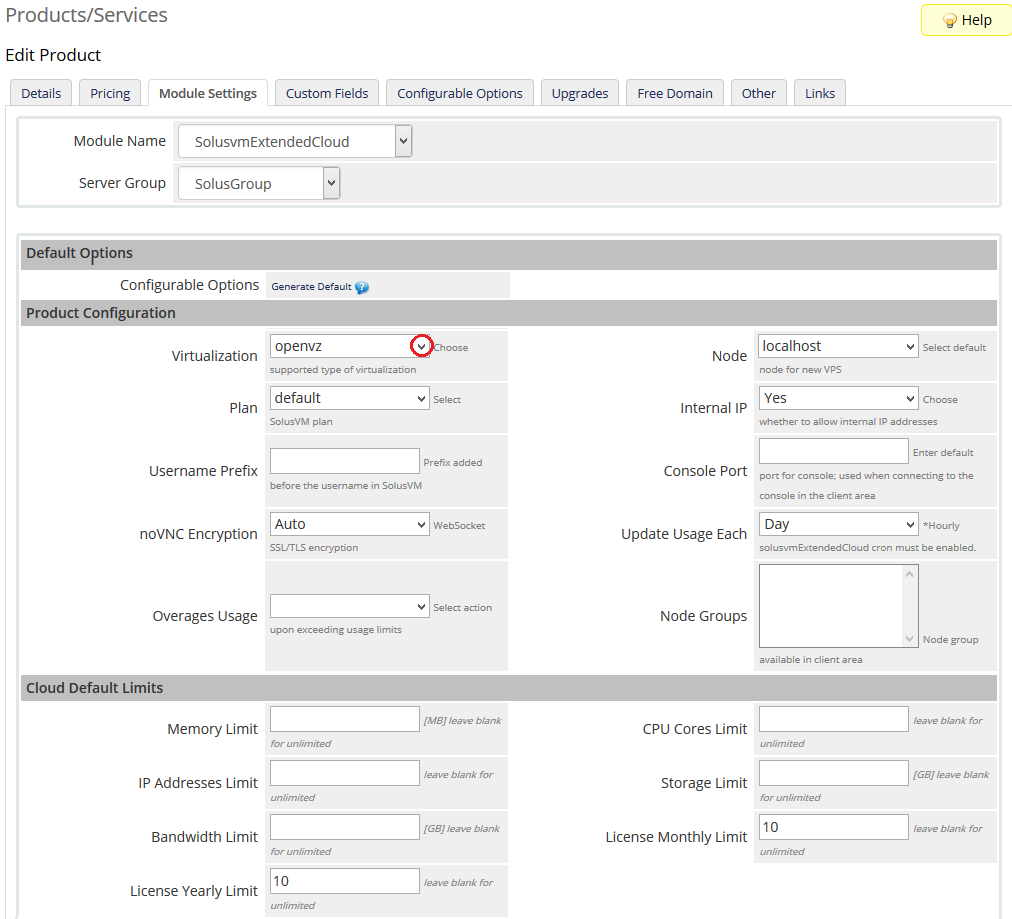
|
17. Now, fill out 'Product Configuration' section.
|
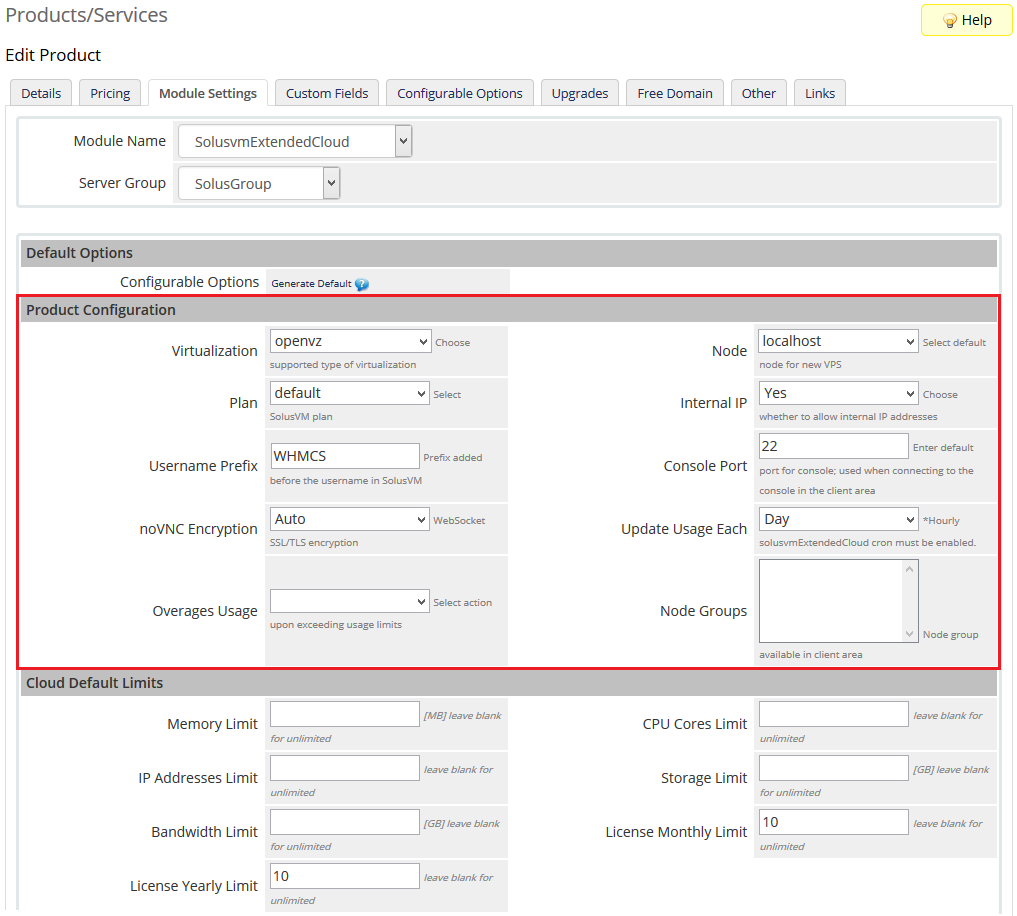
|
| 18. Under 'Client Area Features' section you can define which features will be available for your clients. Feature is enabled when checkbox next to it has been marked. |
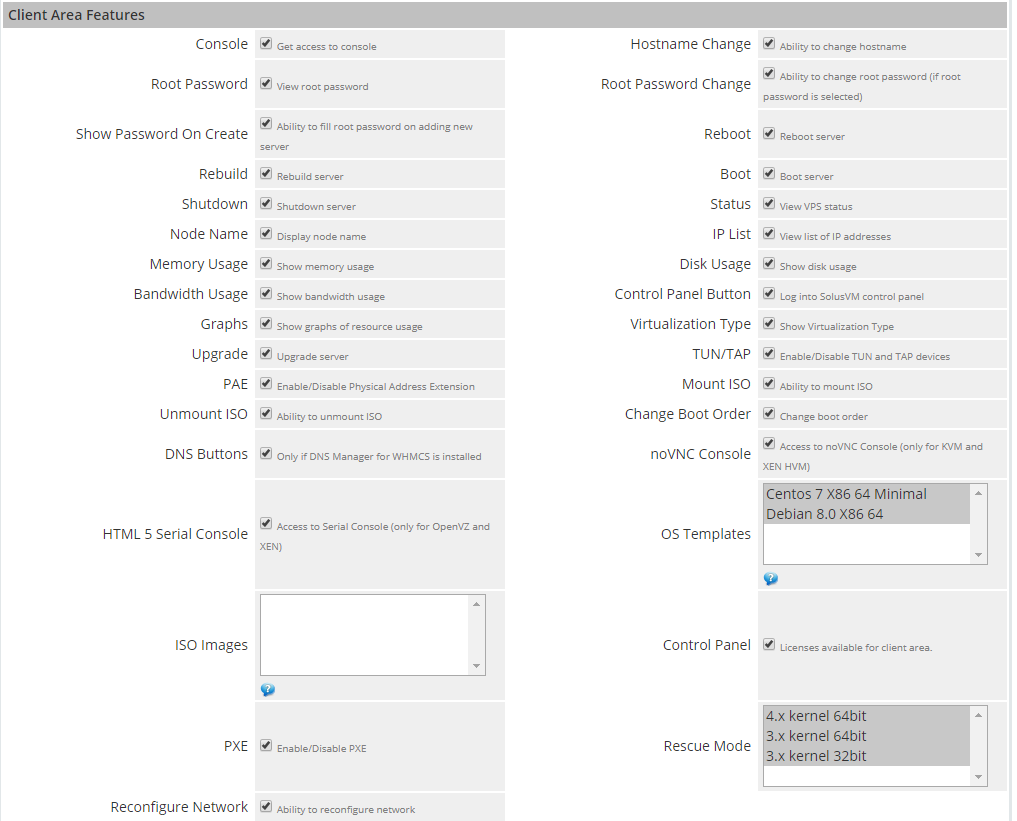
|
Product With Dynamic Resources
| 19. In order to set up a product with dynamic resources, press 'Generate Default' as shown on the following screen. Configurable options allow your clients to pick product with resources tailored to their needs. |
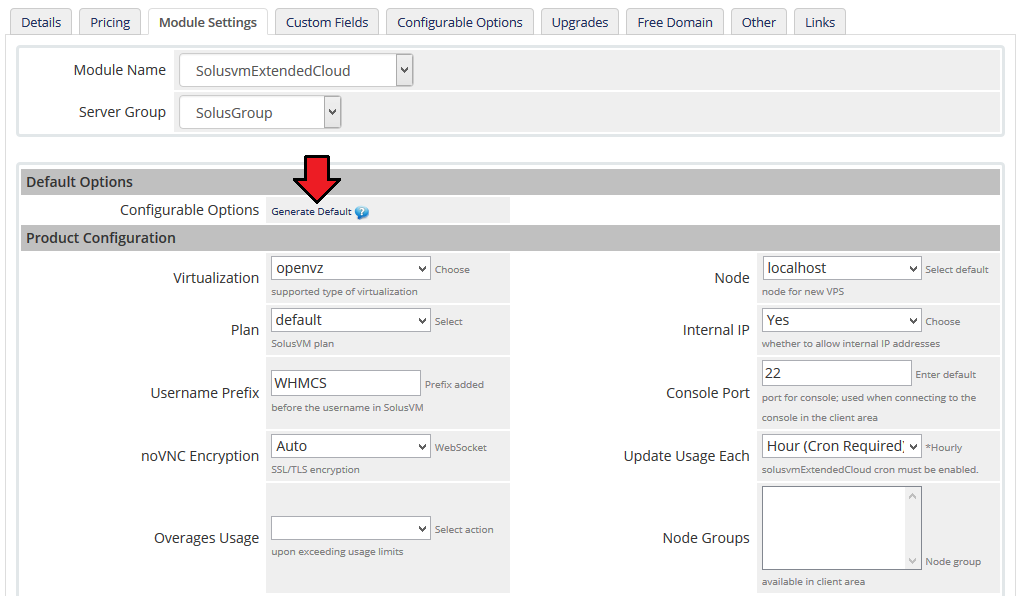
|
Product With Static Resources
| 20. You can also provide your clients with static resources. Simply, fill out the fields marked on the screen below with desired limits and press 'Save Changes'. |
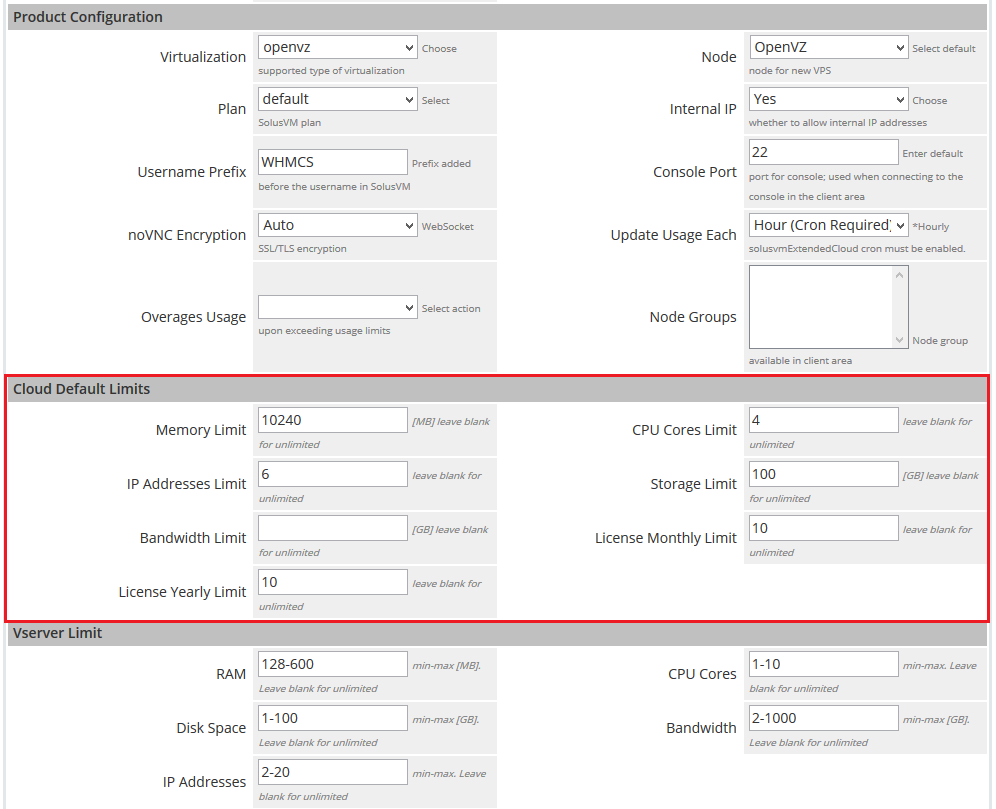
|
| 21. Define resource range limits for new VPS. Set limits within which clients will be allowed to create their virtual machines. It will let you impose some borders on the created VPS. |
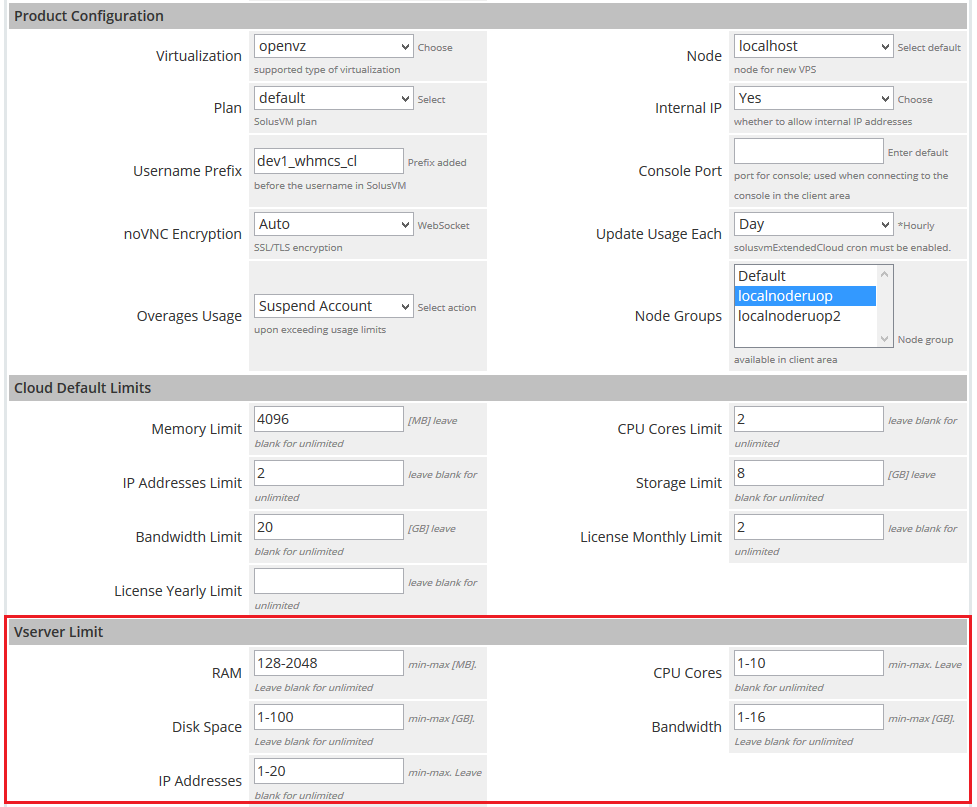
|
| You have just finished the installation and configuration of the module! |
Management
| SolusVM Extended Cloud For WHMCS is very simple and convenient in use. Your customers are only a few clicks away from creating their own servers. The module will allow your customers to manage multiple servers and freely change their resources. Everything within your own WHMCS client area. |
Interface
| Now, let's check the interface of the module in the client area where you customers can create and manage virtual servers. Note: Screen below presents the module right after creation of the product. More features will be displayed after creating a server. |
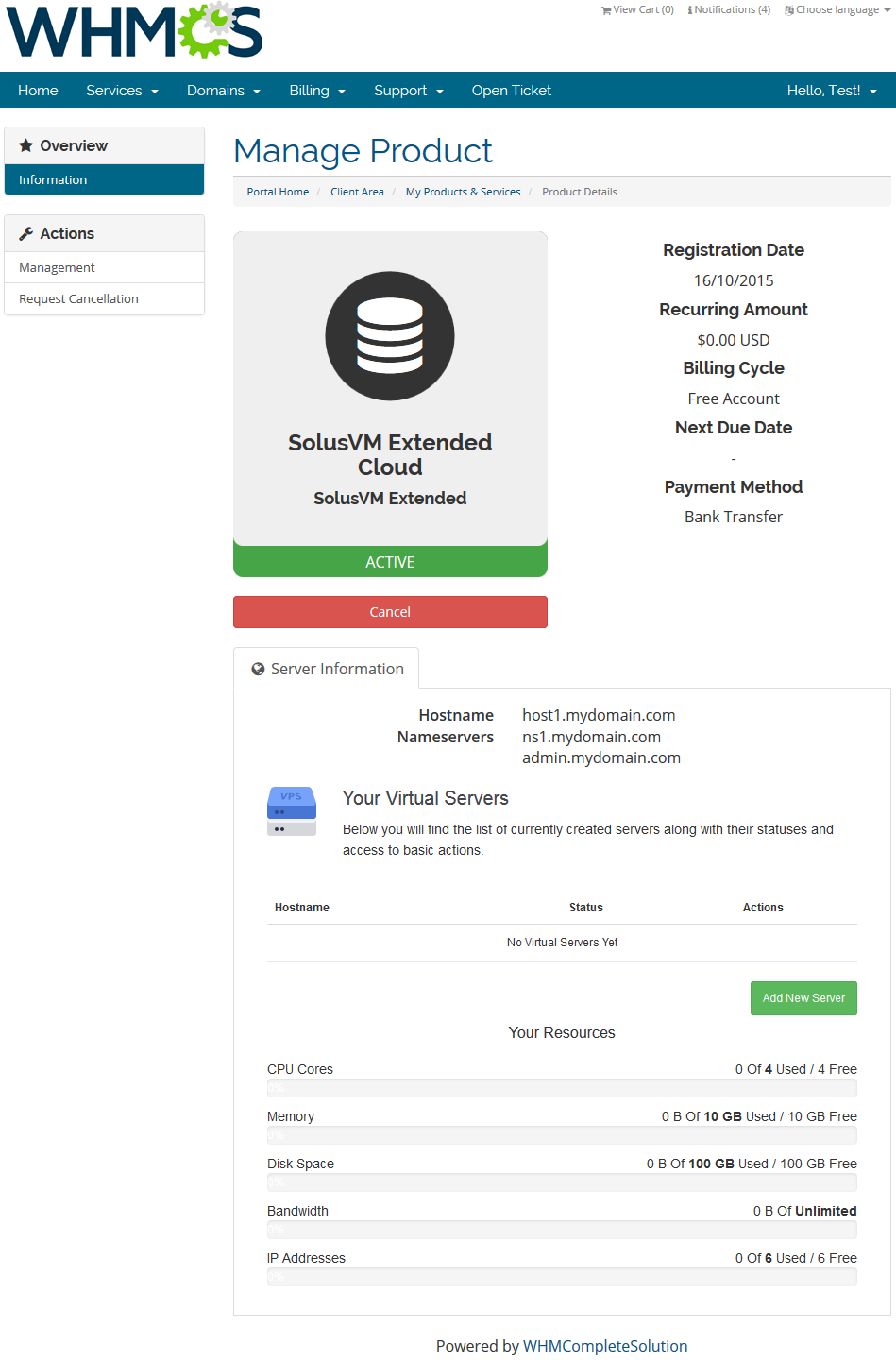
|
| You can manage each product from your WHMCS admin area. In addition to that, each VPS created by your clients can be easily monitored. |
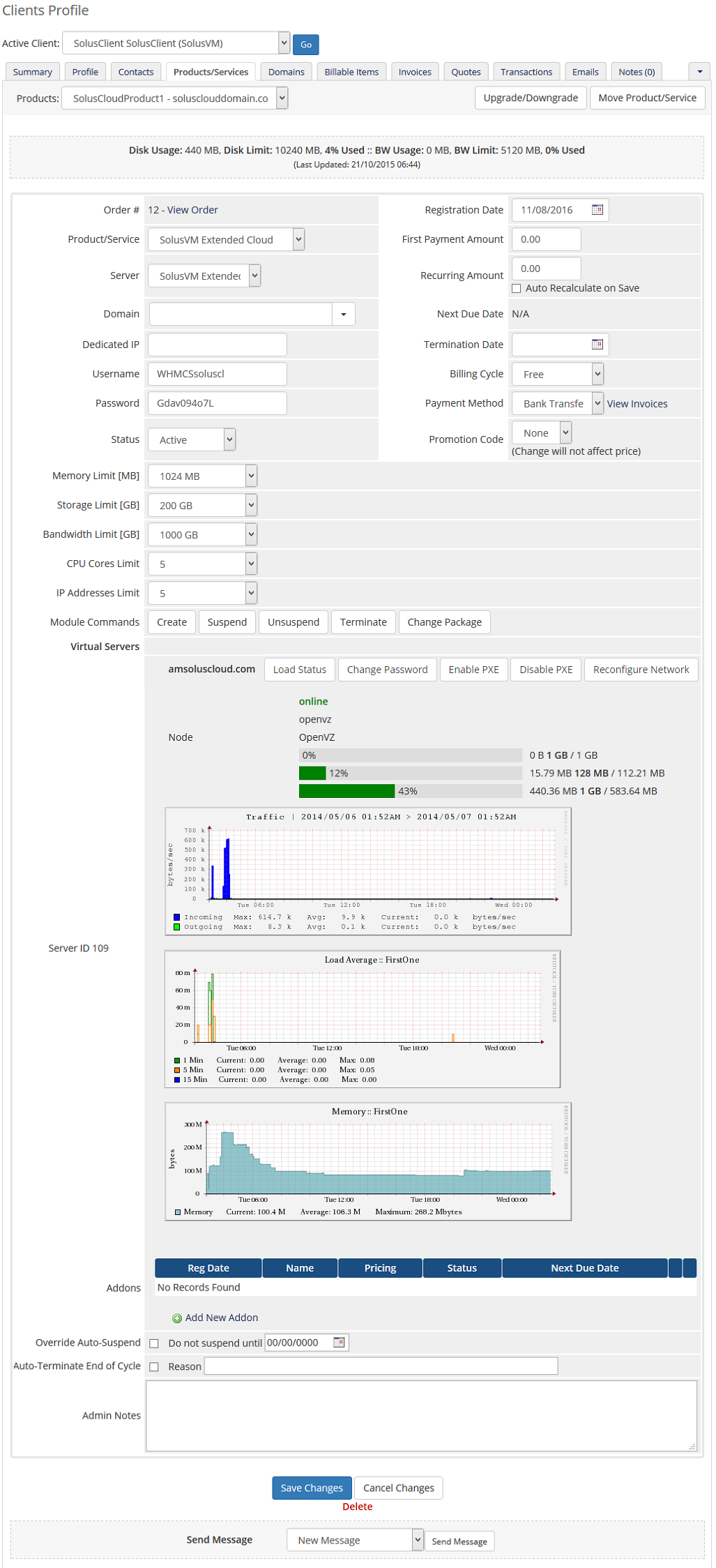
|
Management of Servers
| Let's start by creating a new virtual server. To do so, click on 'Create Virtual Server' button. |
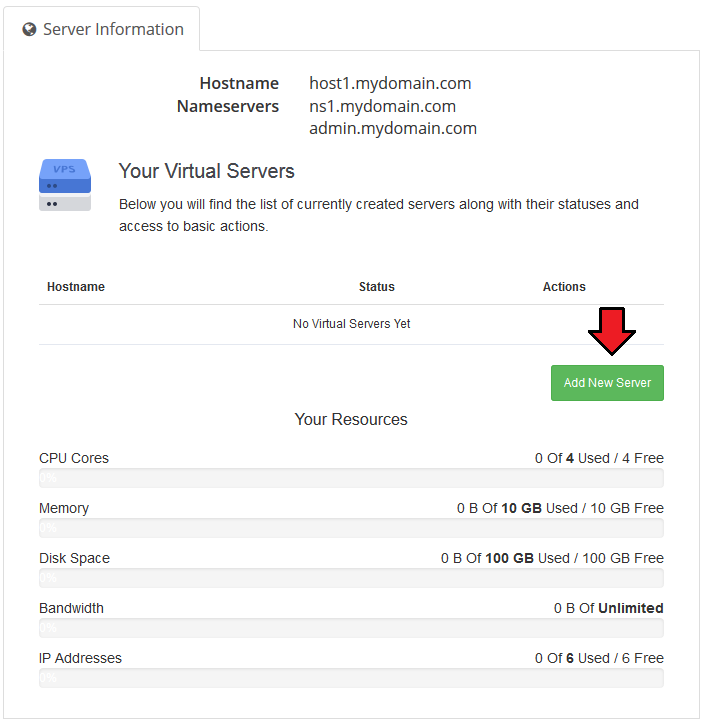
|
| Set server resources and click on 'Add New Virtual Server' button. |
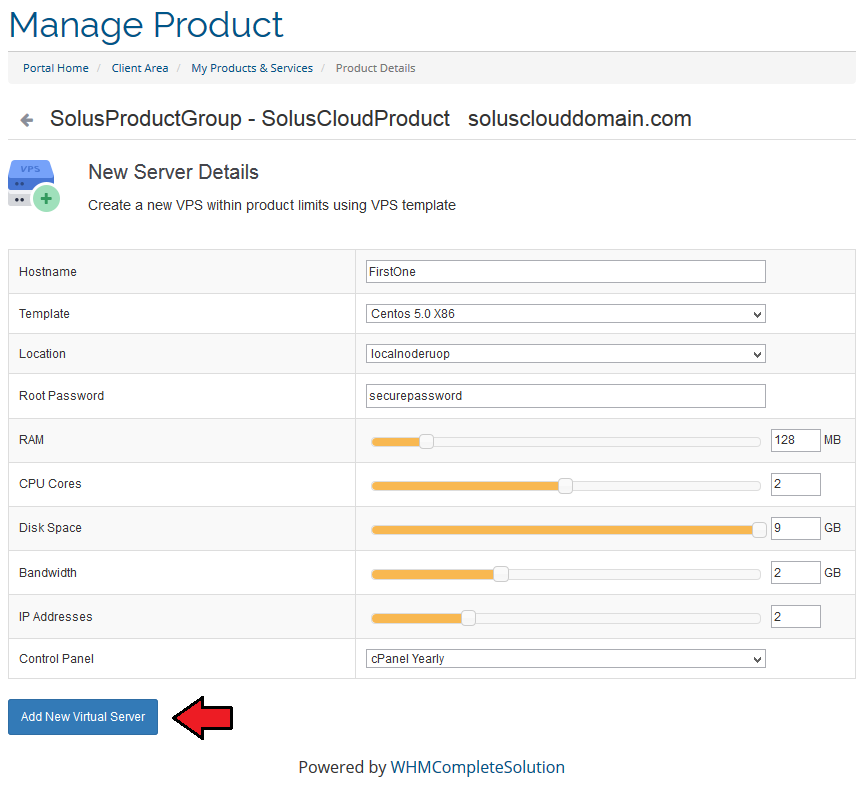
|
| As you can see on the screen below, virtual server has been successfully created. Now let's see how we can manage our new server. To proceed, click on 'Manage' button. |
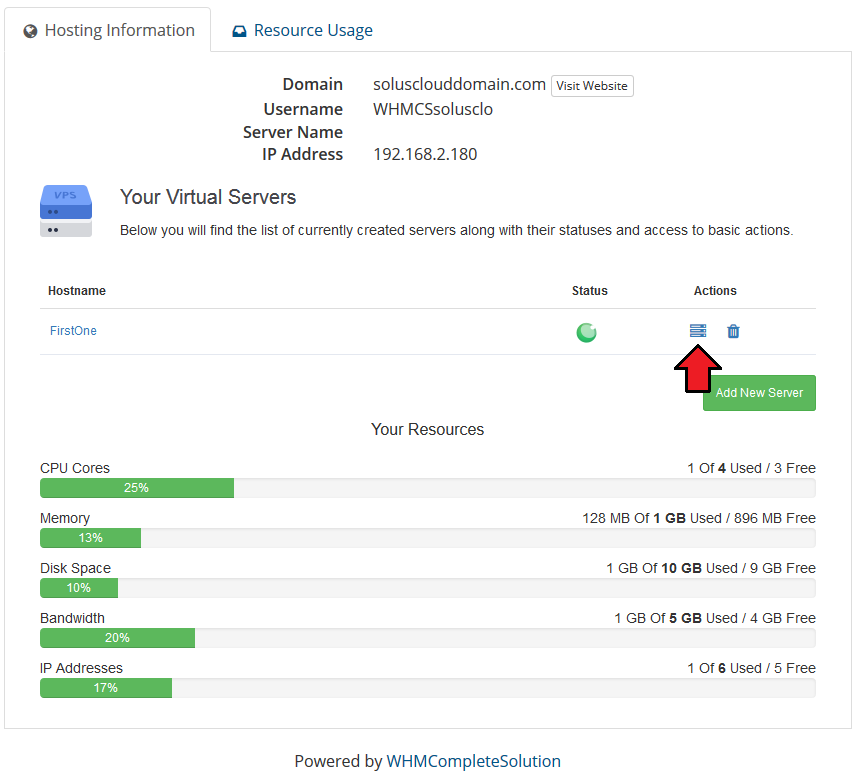
|
| One of the most interesting and useful options offered to the users is the upgrade. Upgrade allows your customers to request a change of virtual server resources. |
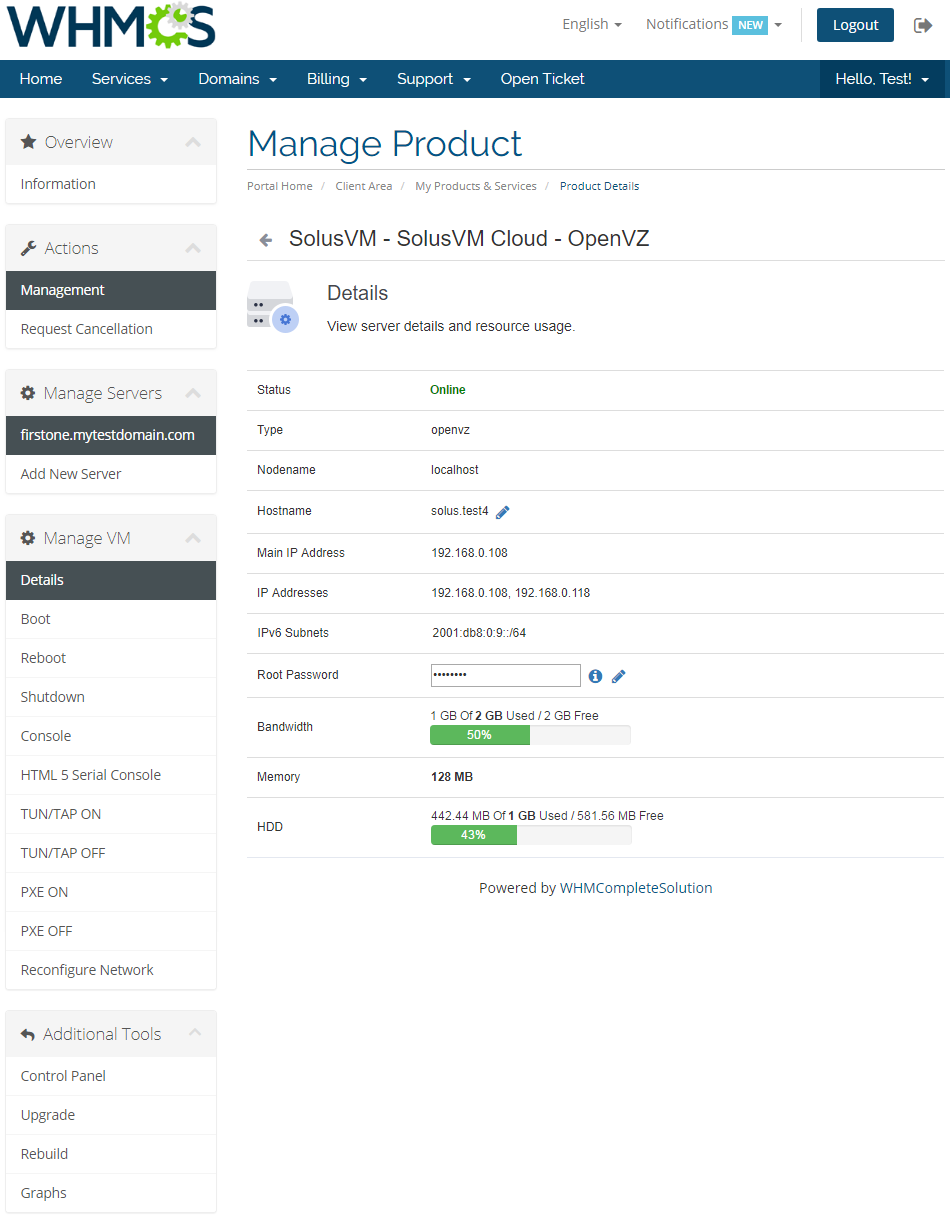
|
| Set details of server upgrade and click on 'Upgrade' button. Upgrade is done automatically, no e-mail notifications or confirmation are sent. |
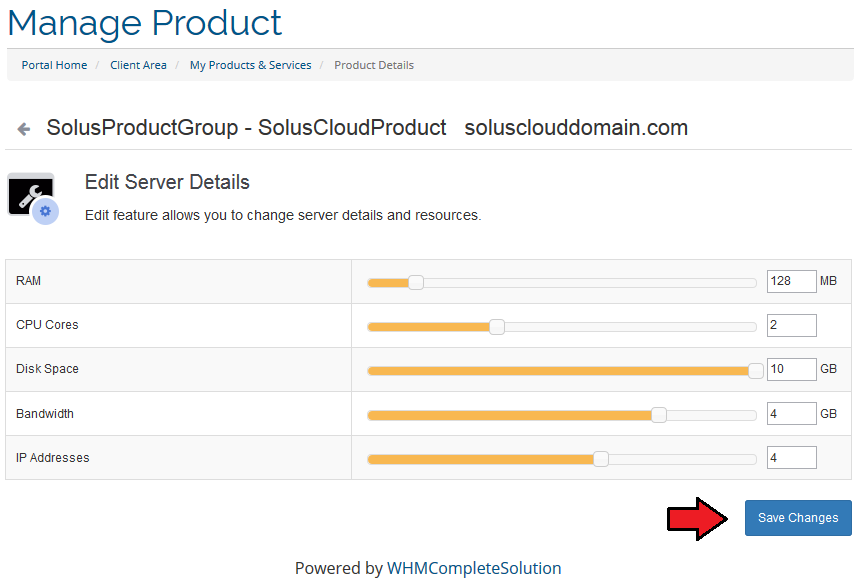
|
| As you can see on the following screen, virtual server has been upgraded. |
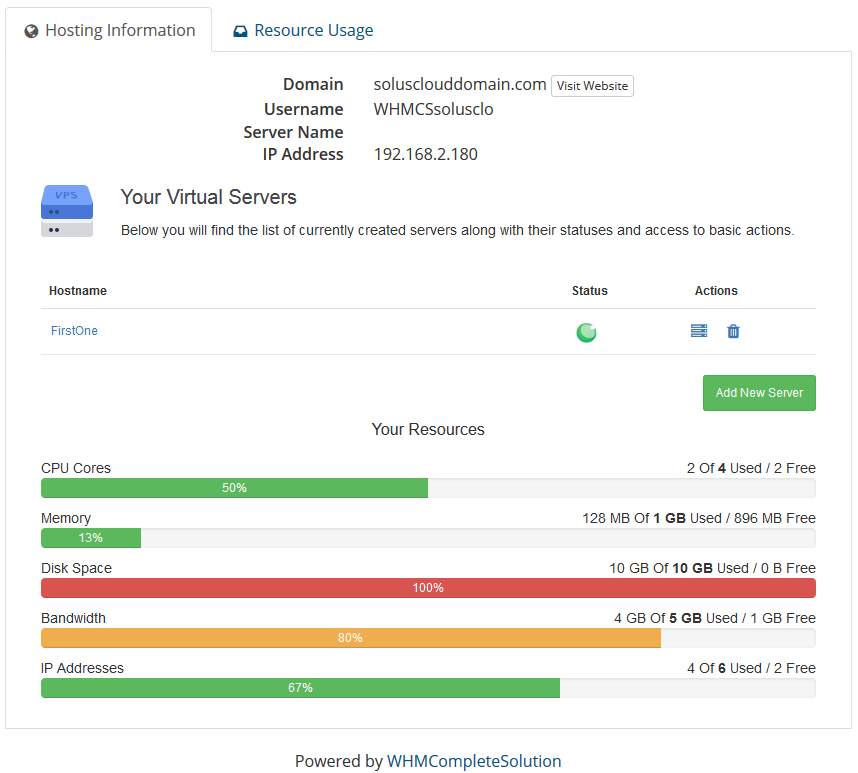
|
| Right next to 'Upgrade' option, there are 'Graphs'. Press it to see generated statistics on 'Network Traffic', 'Load Average' and 'Memory Usage'. |
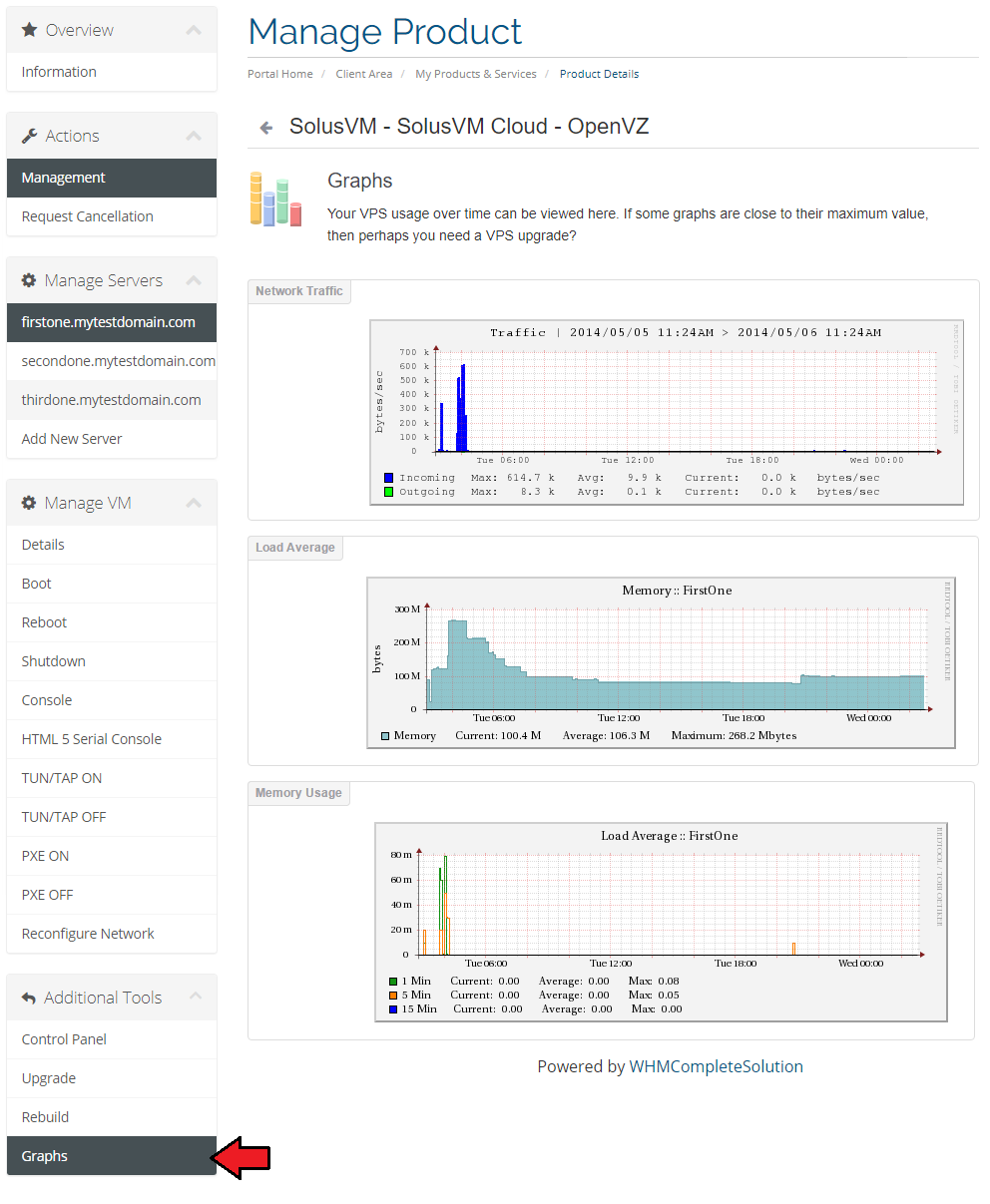
|
| For more information about management of already created virtual server visit SolusVM Extended VPS For WHMCS Wiki |
Dynamic Server Resources Setup With Configurable Options
| If you want to allow your clients to dynamically set servers with resources they choose, follow these steps. Firstly, you should have a ready product. For more information on how to create one, head to 'Configuration of Product' instruction. |
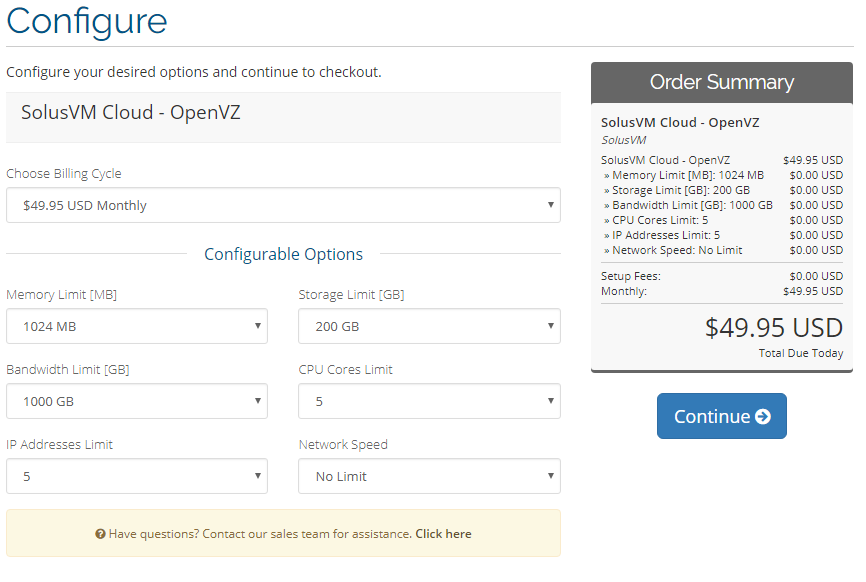
|
| If automatically generated configurable options do not fulfill your clients' needs, you can edit them using this guide. |
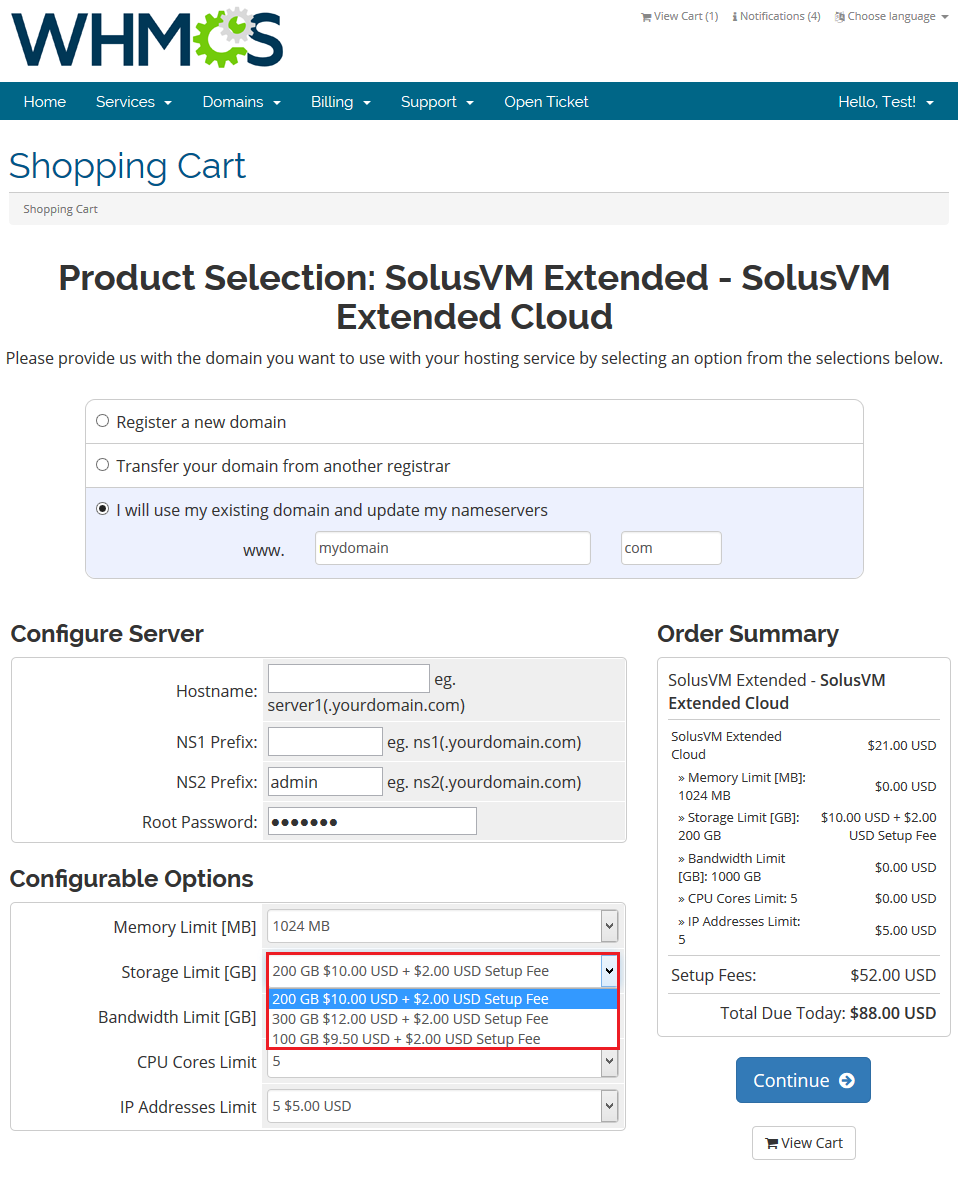
|
| If you decide to set pricing per server resource ordered, you can find instruction for it here. |
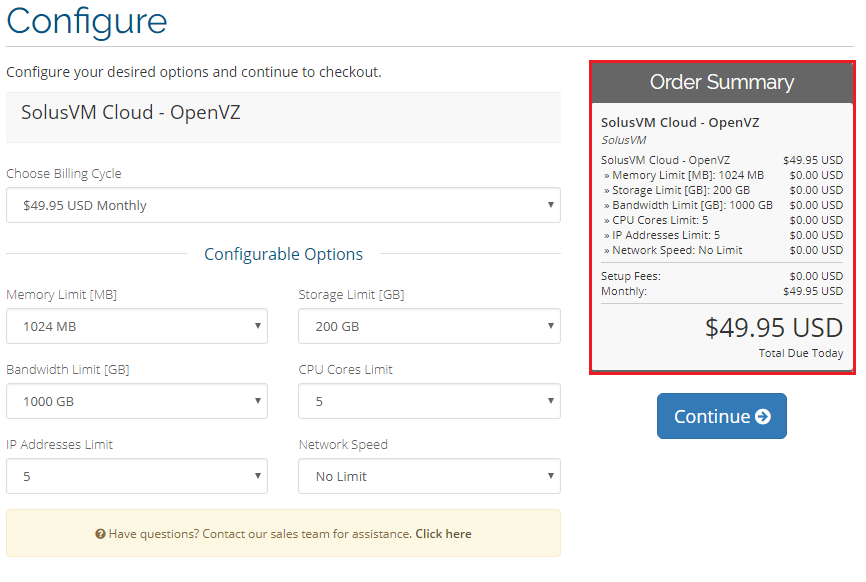
|
| If you prefer to charge your clients for server resources they actually use, you can use our Advanced Billing For WHMCS module. |
Management of DNS
| When you combine SolusVM Extended Cloud For WHMCS with DNS Manager For WHMCS, your clients will be able to manage PowerDNS zones and records from the client area. DNS Manager For WHMCS will allow your customers to manage DNS zones, records and ReverseDNS. |
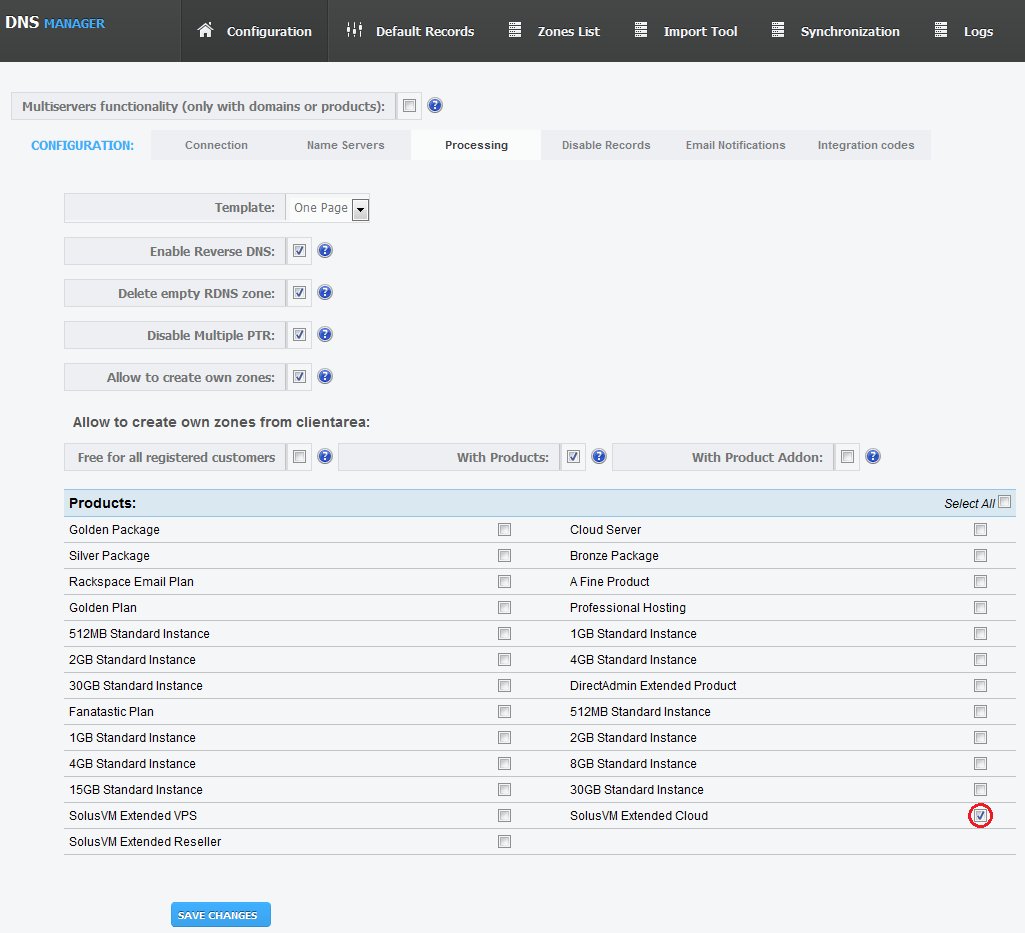
|
| Afterwards, buttons 'Manage DNS' and 'Manage Reverse DNS' will appear in the client area as shown on the screen below. |
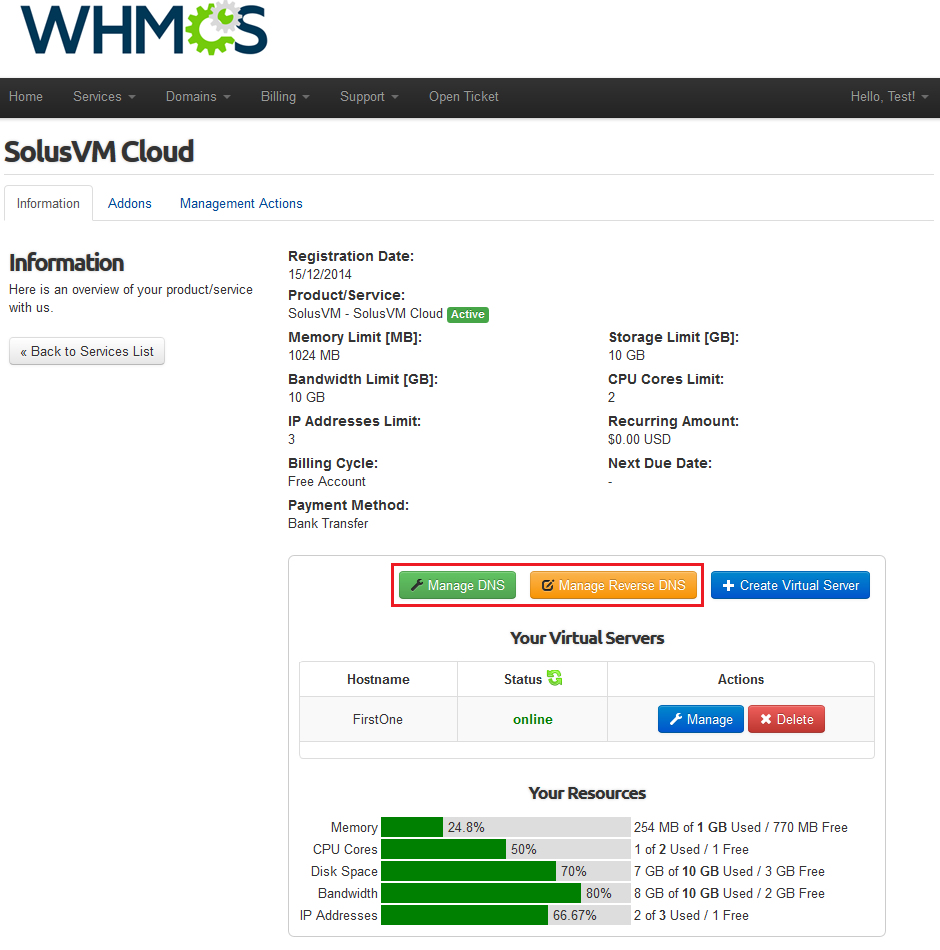
|
| Depending on previously chosen settings, your customers will be able to add, edit and remove DNS zones and records. |
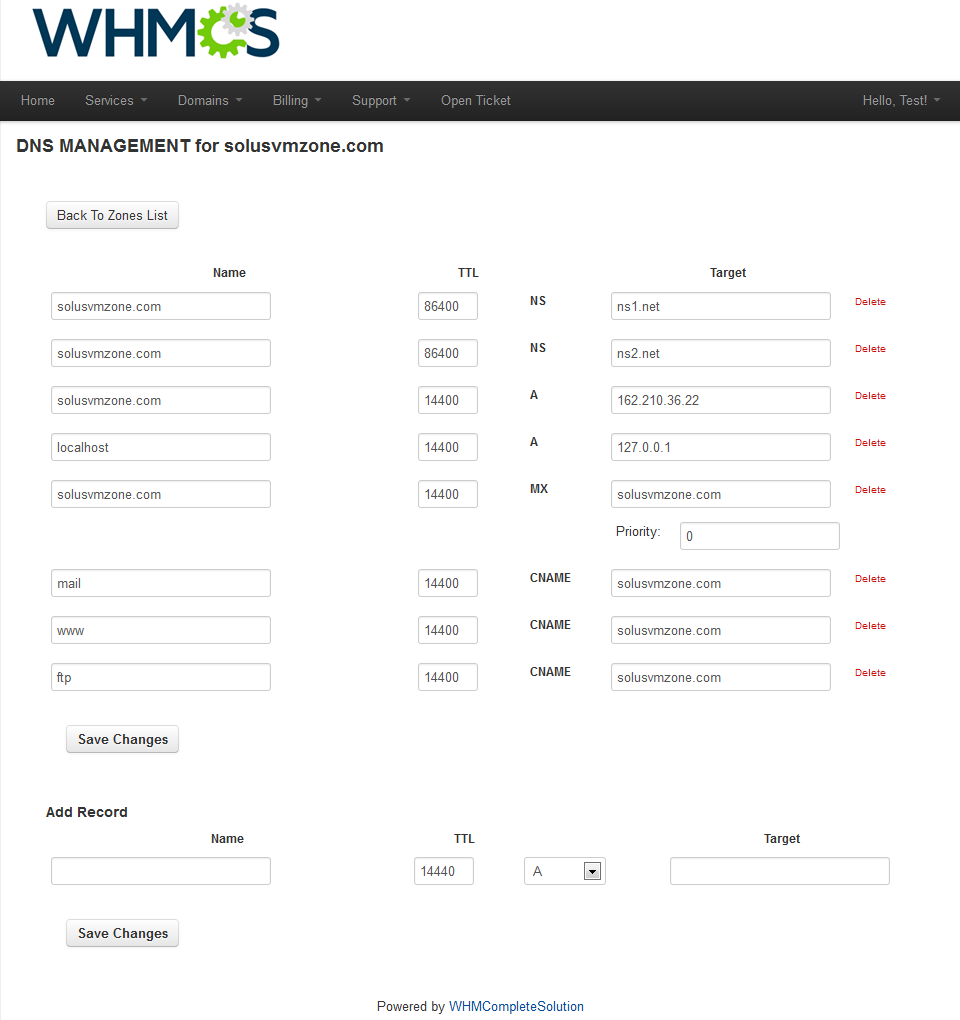
|
| Module will also allow your customers to add, edit and remove Reverse DNS zones and records. |
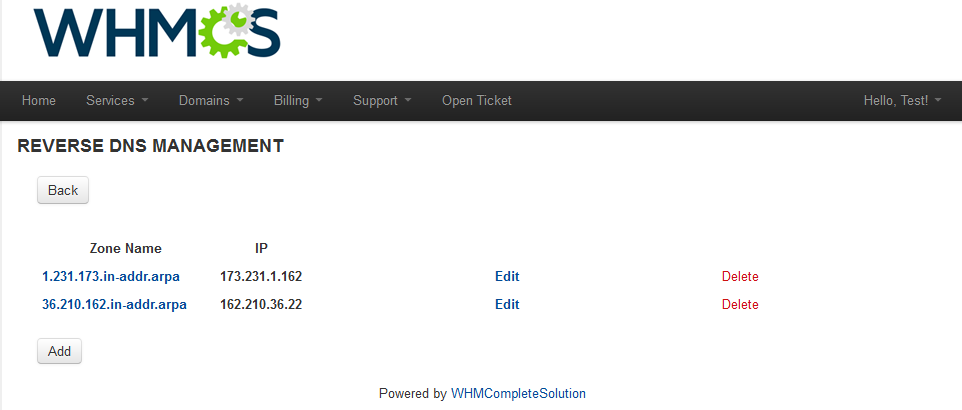
|
Management of Billing
| When you combine SolusVM Extended Cloud For WHMCS with Advanced Billing For WHMCS, you will be able to set up additional billing options. Enable 'Usage Records' extension for Solus Cloud products. |
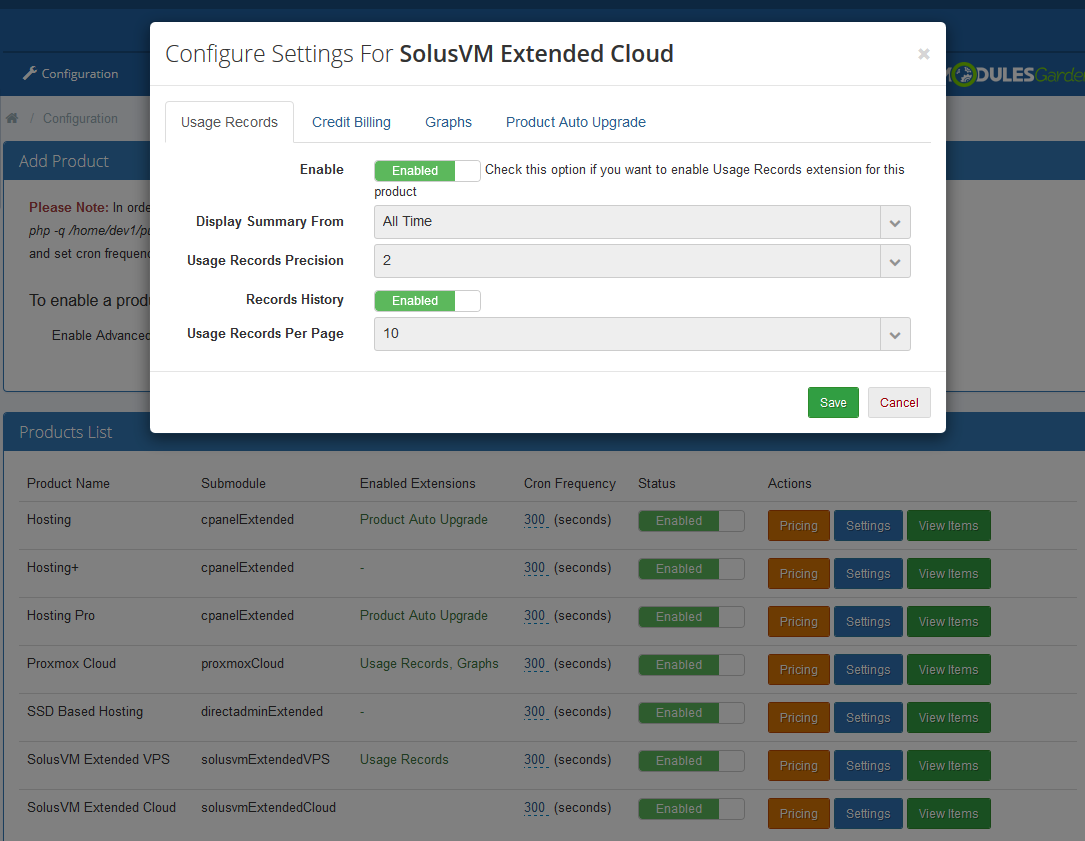
|
| The module allows you to charge your customers basing on the server resources used by them. Set free limits and pricing for used records. |
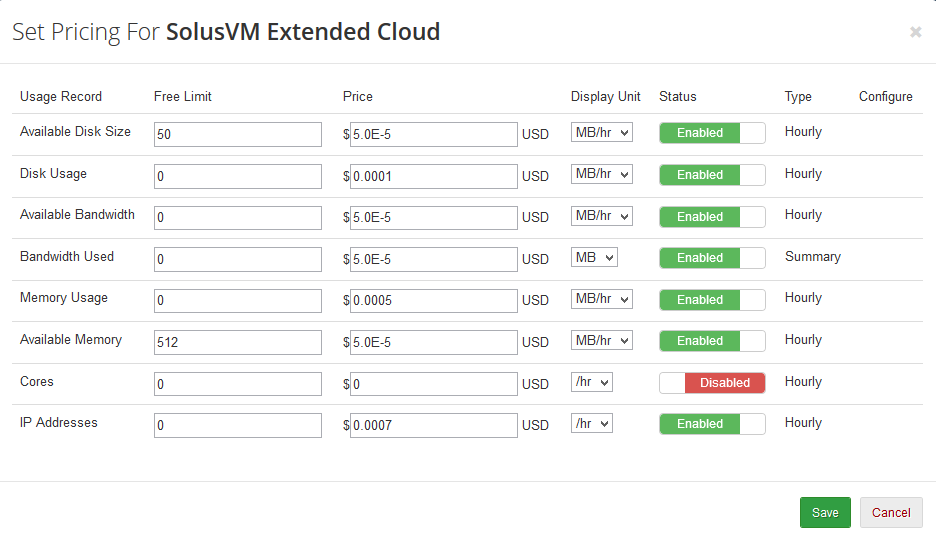
|
| With Advanced Billing module, you can also display the current server resource usage and its cost for your customers. |
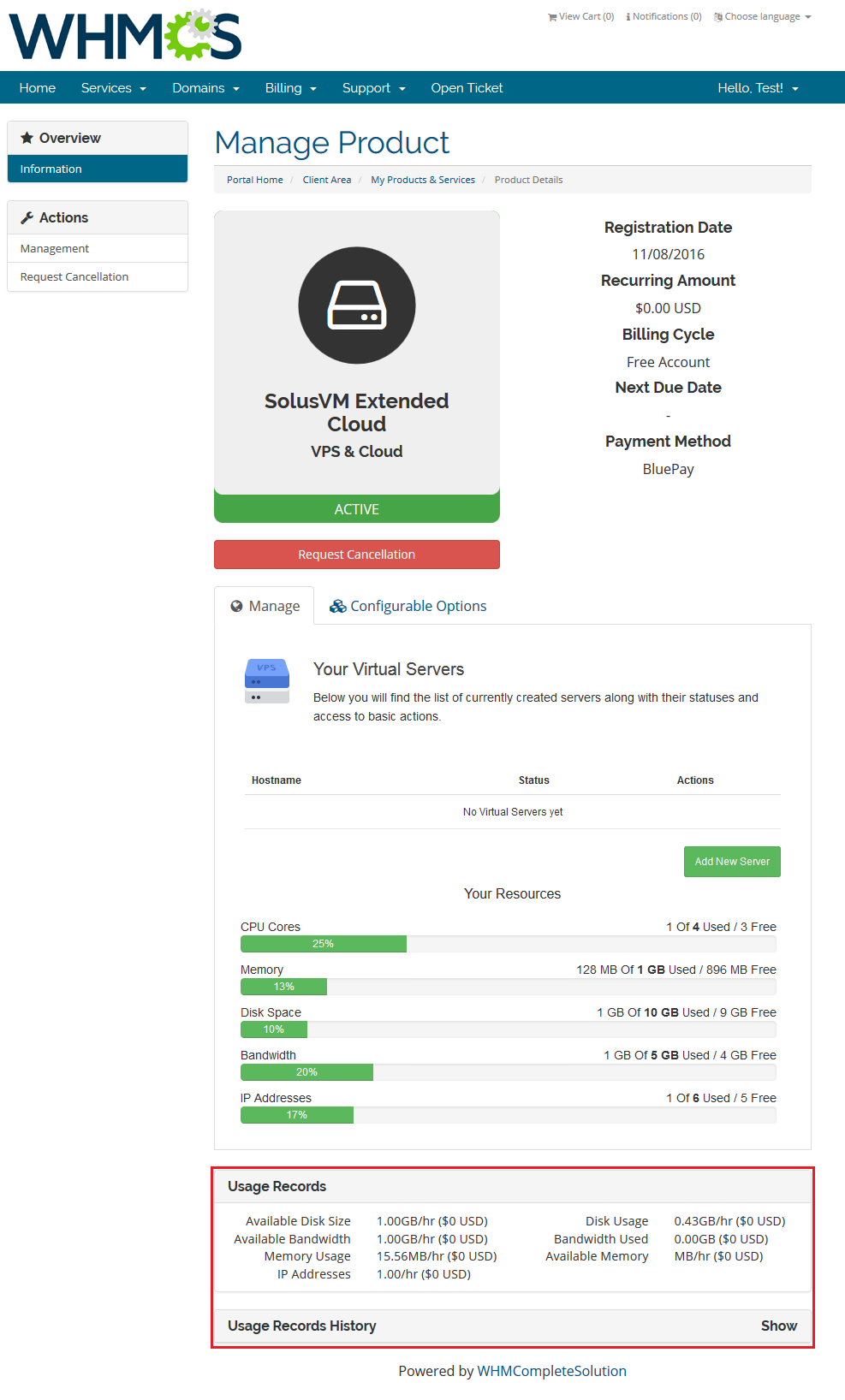
|
Update of Products
| Our module is entirely compatible with SolusVM Pro module and you can easily upgrade your existing products without losing your settings. 1. Go to 'Setup' → 'Products/Services' → 'Products/Services' → 'Module Settings' of your product and switch 'Module Name' from 'Solusvmpro' to 'SolusvmExtendedCloud' . |
Debug Mode
| SolusVM Extended Cloud is a very complex module. Therefore many things might go wrong. To help you quickly solve various problems usually connected with WHMCS product/server configuration and SolusVM server configuration, we created 'Debug Mode'. |
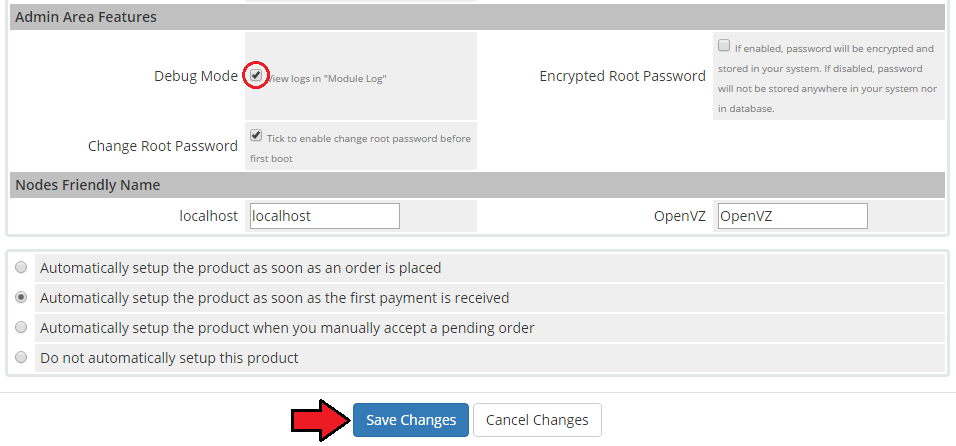
|
| Afterwards, go to 'Utilities' → 'Logs' → 'Module Log' and click on 'Enable Debug Logging' in order to enable it. The button should change its value to 'Disable Debug Logging'. From that moment, each action performed by the module will be recorded in the log. |
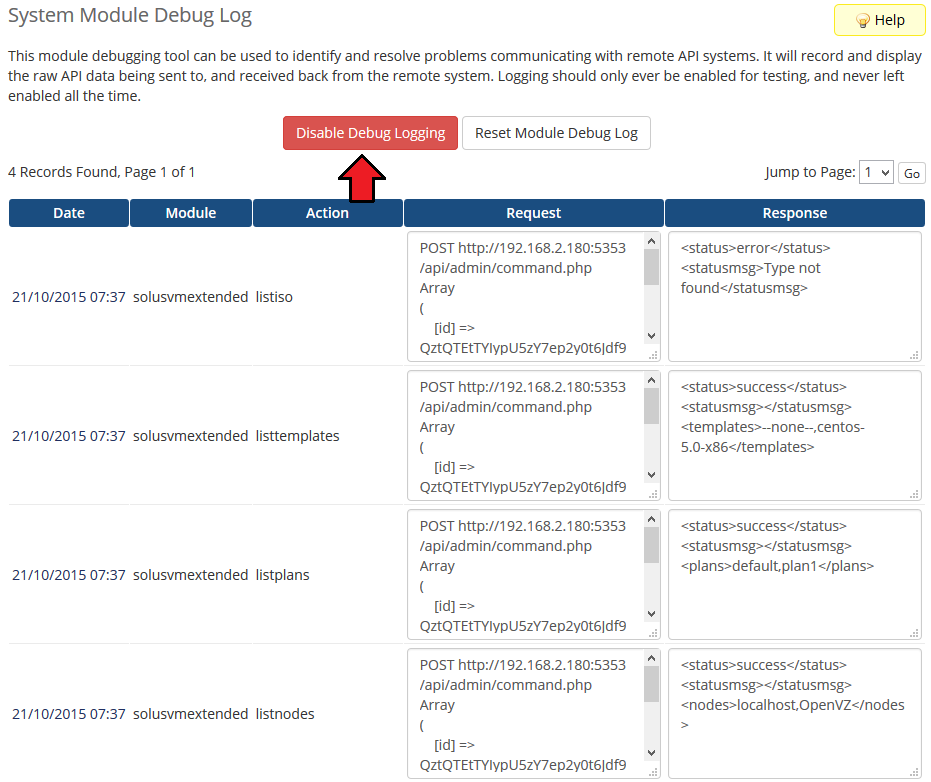
|
| Remember to turn off Debug Mode after you fix the problem. |
Locations Management
| Underneath, you will find a short description of a real life example of managing and rotating between locations with SolusVM Extended Cloud For WHMCS. Take a quick look at it and note the flow. |
| Let's assume that Mr Smith has one master server called 'Master'. This is the server Mr Smith configured and connects with from WHMCS with the help of our module. This server contains 3 slave servers configured in his SolusVM environment. These are:
These three slave servers are server nodes. In this configuration example, all of Mr Smith's clients order products on 'Master' server and so they receive resources available on server 1, 2, 3. |
Tips
| 1. We made every effort to make our module as easy to install, configure and use, as possible. Therefore we paid special attention to displayed messages. Read carefully each message, follow the instructions and you shall have no problems with using the module. |
| 2. Operations performed on the virtual servers are not executed immediately. Give your SolusVM server some time to process the request and execute the operation. |
Common Problems
| 1. When you have problems with connection, check whether your SELinux or firewall does not block ports. |
| 2. The vast majority of problems are connected with misconfigured SolusVM server or misconfigured servers/products in your WHMCS. Firstly, make sure that your SolusVM server has properly configured virtual servers, nodes, node groups, templates, plans and API access. |
| 3. By default our module connects with SolusVM server on port 5353. If you are using different port, you need to specify it in 'Hostname' field. Default port for SSL connections is 5656. To connect on that port enter your hostname as follows: 'yourhostname.com:5656' . Keep in mind that you can connect on any port. |